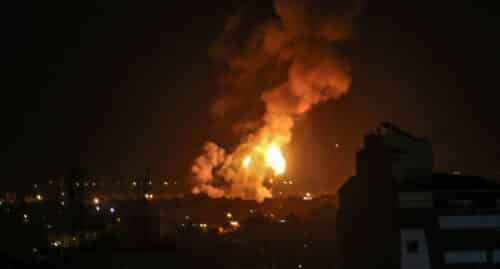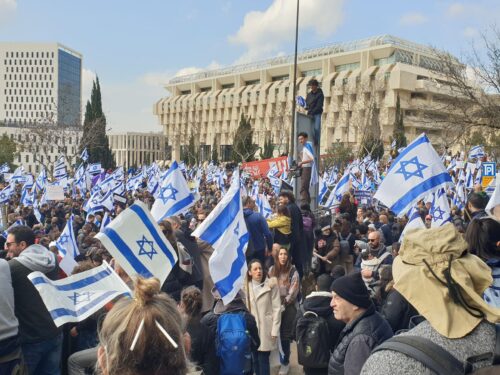For the first time in decades, Israel is waging war for a clear, unambiguous objective. At the start of the operation, the government already declared its objective — to destroy the terrorist organizations in Gaza and dismantle their military capabilities. There is only one military effort that can do so: total conquest of the Gaza Strip and at least several months of mopping up there. Afterward, in order to prevent the problem from ever recurring, we will need to occupy a sizeable swath of the Gaza Strip adjoining the Egyptian border and retain complete freedom of military action in the entire Gaza Strip. On that understanding, we must ask ourselves whether we can successfully manage an extended military rule in Gaza without civilian settlements.
The political error that may cost the IDF its victory
We Israelis generally associate settlements with their religious, political, and ideological aspect. But I am approaching my consideration of the settlement movement first and foremost from the standpoint of national security. The Mapai party believed correctly that settlement is a multiplier of security power. For secure survival in the Land of Israel, there are three models and the State of Israel has already tried all three.
The first model is disengagement. We tried that model in Gaza, and as we all saw, it failed decisively. That model enables the other side to amass power without limit, and the results have been made clear in the recent attack on Israel. If we applied that model in Judea and Samaria, heaven forbid, there would be a war here that the IDF could not win and Israel would cease to exist.
The contention can be heard today that the settlements in Judea and Samaria are a strategic burden and that our failures on October 7 arose partly from the stationing of large IDF contingents to defend those settlements. But the reverse is true. By protecting the coastal area, the settlements in Judea and Samaria enable the state to remain in existence. The State of Israel cannot survive if restricted to the coastal plain — an area 15 kilometers wide, at sea level, in the shadow of hills that provide a complete view and an opportunity for attacking Israel’s cities. The topographic advantage is no trivial matter. Over history, Israel has defeated great empires and great military forces by virtue of that advantage. Moreover, a third front would seriously challenge the IDF, which is currently under strain from a war on two fronts.
If a force were to arise in Judea and Samaria similar to the force that arose in Gaza, it is doubtful that we could defeat the enemy; and even if we did, we would pay a very heavy toll. Our enemies would need no more than some years of calm, during which we would see no justification for trying to foil their buildup while they made their way toward a readiness to attack. Although we have become accustomed to believing that there is no challenge the IDF cannot meet, the IDF cannot solve political irresponsibility. The IDF is strong only when given the opportunity to use its power. If the political decision-makers do not prevent a buildup of terrorist strength in the hills, then even the IDF cannot prevail.
Two ways to prevent the strengthening of terrorism
An absolute majority of the Israeli public already understands that disengagement is not an option — neither in Judea and Samaria nor in the Gaza Strip. That said, what is to be done?
Today there are two approaches. The first favors military rule. We have seen such a model employed in the past: in Afghanistan, for example, both by the Americans and by the Russians. Similarly, it was the US method for managing Iraq. And this is another method that Israel too has already tried — in South Lebanon.
Viewing Judea and Samaria on the one hand and South Lebanon on the other, the comparison is interesting because both are small territories and both contain non-Jewish populations. Where there is no project of Jewish settlement producing activity of its own on the roadways, a dynamic develops resembling that of Iraq and Afghanistan: a retreat into fortresses, constant efforts to reopen the roadways, dealing with explosives and ambushes, and investing much of the military’s energy in convoys of tanks and armored personnel carriers.
In Judea and Samaria, the situation is completely different and the entire reason is the settlements. Whereas in South Lebanon if we wanted to drive to a military position of ours five or seven kilometers from the border, we needed to ready ourselves with battle plans, tanks, armored personnel carriers, and hummers, today any civilian can drive to Ariel alone in a car without armor. Ostensibly, the situations are equivalent: in both cases, the IDF is in charge of the territory. But settlements make all the difference. The moment there is a critical mass of settlements, with tens of thousands of their vehicles constantly traveling the roadways, they keep the routes alive with everyday use and they dominate the area.
The same phenomenon is visible inside Israeli territory, in the Negev and Galilee. In the Negev during Operation Guardian of the Walls, we saw traffic on the road between Beersheba and Dimona halted for three days, during which no supply of ammunition and no fresh troops could reach the nearby air force base. Why? Because the road is surrounded by a scattering of Bedouin villages without one Jewish settlement among them. The local Bedouin decided to close the road, and it closed.
In the Galilee as well, the Jewish settlements are of enormous importance. When Maj. Gen. Itzik Turgeman retired as head of the IDF Technological and Logistics Directorate roughly two years ago, he made an astonishing statement: If there is war in the north, the IDF will not pass through Wadi Ara. So inside the territory of Israel proper, there is a central artery — one of only two that exist — where the IDF cannot move its forces from south to north and back, and the sole reason that it cannot is that the route is surrounded by Arab cities and villages whereas Jewish settlements are absent.
The need for vision and permanent solutions
Another problem with military rule is that after a short while, it begins to be considered illegitimate. As little as 20 years from now, the memory of the October 7 disaster will begin to fade; and what happens then? Being intended as temporary, military rule can never provide a solution down through the generations. If we do not decide now with a view to the endless future, then in ten or fifteen years a civil rebellion will rise up in Gaza or Rafah against IDF activity, and the IDF will need to withdraw — as it did in Lebanon, where Hezbollah, as a result, is stationed today at our border.
After being twice exiled from our homeland and undergoing expulsions, pogroms, and the Holocaust, we must not forget the mighty task that has devolved to us — ensuring the security of Israel for the long, long term. That is why our state was founded, and our duty is to preserve it. Thus we must not fall prey to fanciful slogans about Israeli security. After what occurred on October 7, we must all approach discussions of this kind with reverent humility, because mistakes could carry a heavy cost.
Wartime is not the moment for deciding on issues with long-term ramifications, such as settling civilians in Gaza. At present, the nation of Israel must stand united around the war’s two goals — dismantling the rule of Hamas and of terror in the Gaza Strip, and returning the hostages. It is clear, though, that at the end of the war we cannot avoid such decisions and we will need to formulate a clear long-term vision for the State of Israel. Without such a vision, we will not have the fortitude for doing what we must in order to preserve the State of Israel down through the generations and to shape our destiny with our own hands.





